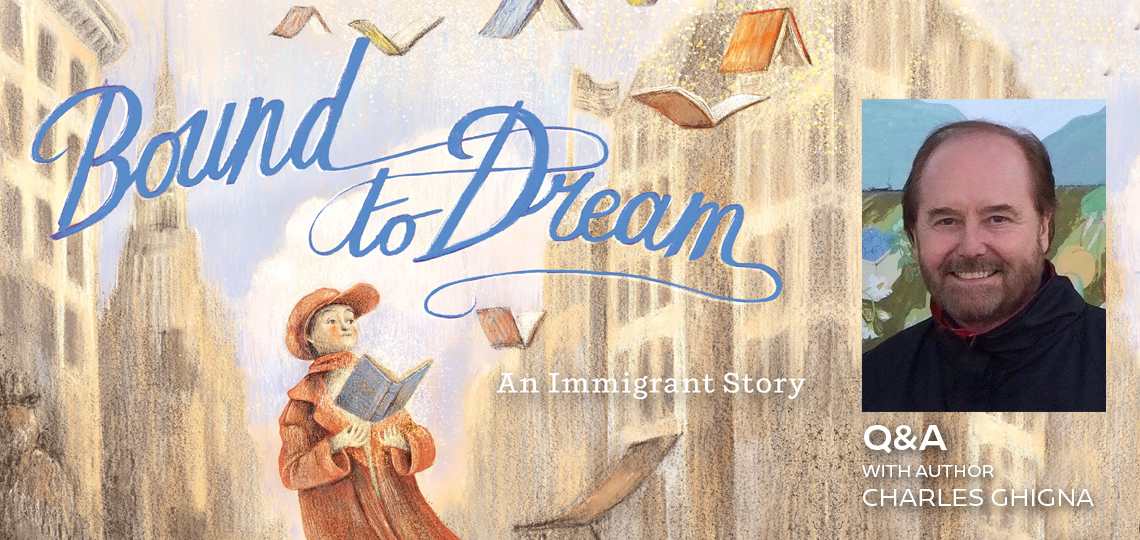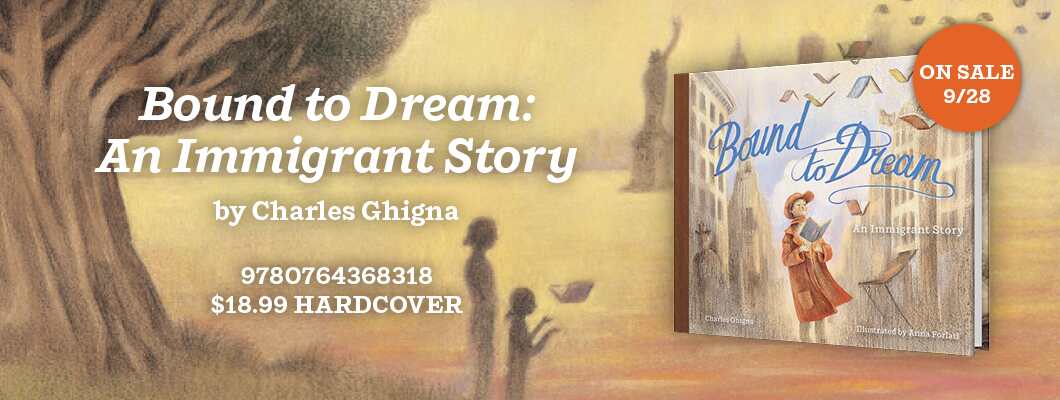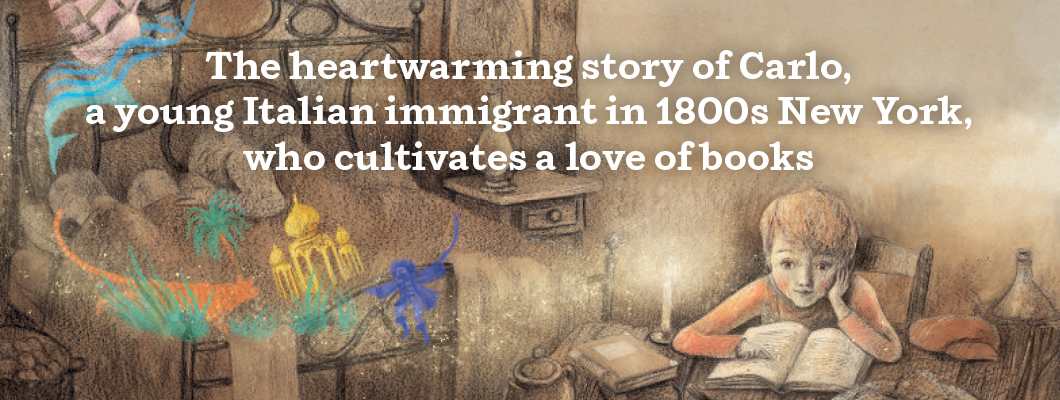DREAMS from the Tree House!

A Conversation with Charles Ghigna, Author of Bound to Dream
Today, we’re thrilled to hear from Charles Ghigna, Father Goose himself, on the upcoming release of his latest illustrated children’s book, Bound to Dream. An immigrant story that recounts the journey of Ghigna’s great grandfather from northern Italy to the hardscrabble streets of nineteenth-century New York, Bound caught the attention of Foreword‘s children’s book editor, Danielle Ballantyne, and we connected the two for the following conversation.
Before making the transition to full-time author, you were a high school English teacher and university professor. What inspired you to make that leap?
It was always an honor and a privilege (and a challenge!) to wake up every morning and enter a classroom full of eager faces looking up to me for their daily fix of literary goodness and inspiration. From day one, I saw that famous Sarah Teasdale quote come alive before my eyes: “Children’s faces looking up, holding wonder like a cup.” It was a mutual love and respect between mentor and student. I still cherish the fond memories of those early years when I would come home each evening spent from teaching all day, then spend my nights grading papers, preparing new lesson plans, and brainstorming ways to bring new bushels full of fresh inspiration into the classroom the next day. Late at night I wrote. And wrote. And wrote. Filling notebooks full of my dreams and poetry. On a lark, I submitted one of my first serious poems to Harper’s Magazine. They published it! I was hooked.
New poems poured out and began appearing in literary journals. A university press published my first collection. I became the quintessential brooding poet, high on my pursuit of writing the perfect serious poem, until one day my beloved wife looked at me and said, “You need to lighten up.” “What?” She said, “Instead of writing another serious poem (that no one reads), why not use your silly sense of humor to write something for children, something everyone can relate to and enjoy.” “Like what?” I asked. “I don’t know. Maybe something about dogs and cats,” she quipped.
Ha! I stormed off up to the tree house. I’ll show her. I spent that night writing Good Dogs Bad Dogs and Good Cats Bad Cats. I dropped off the manuscripts at the post office on my way to school the next day. The Walt Disney Company published those first two books and asked for more. I signed a four-book contract with them and left the classroom to write full-time. A bushel of books later, I realized my wife was right. Now, when I’m not up here in the tree house writing, I like to travel to schools, colleges, libraries, and conferences sharing the power and joy of poetry with children everywhere. I reach more students now through my books and talks than the number of students who years ago helped give their young teacher his first pair of writing wings.
Across thousands of poems and over a hundred books, you have earned the moniker “Father Goose.” Where did that nickname come from?
With a last name as difficult to spell and pronounce as Ghigna, it was obvious I needed a pseudonym, something friendly and fun for kids to say. Many years ago during my school visits, teachers and students started calling me “Father Goose.” My editors at Disney Publishing liked that idea. They asked artist Cyd Moore to create an image of Father Goose for the cover of my first picture book of poems for children, Tickle Day: Poems from Father Goose. That image of Father Goose also appears in little cameos throughout that book.
Over the years, other illustrators added their interpretations to the growing list of Father Goose images that appear in books and magazines. Now, some thirty years later, the talented team at Schiffer Kids invited the stylistic Italian artist Sara Brezzi to create the imagery for my beautiful new Father Goose Treasury of Poetry for Children. Sara’s stunning images are breathtaking. Her artistic images of Father Goose show him as a majestic bird in flight. One of her last images in the book portrays a dramatic, dreamy image of Father Goose. He is seen flying off the page and out of the book followed by a younger goose who represents all the children who sail away into the future upon the wondrous wings of imagination.
For those who might wonder about the pronunciation of Ghigna, here’s an audio link from the website at FatherGoose.com. https://school.teachingbooks.net/pronounce.cgi?aid=5467
Writing books for children, let alone so many, requires an endless well of imagination. From where do you draw inspiration?
The wells of inspiration are deep and waiting everywhere for all of us to enjoy! All we have to do is slow down and take a look. Slow down and listen to sounds at the bottom of the well. I’m particularly inspired by little things, quiet moments. I listen and observe. I celebrate life. I practice gratitude. I take long walks. My inspiration and ideas come from nature, children, pets, animals, family, friends, and from the real and imagined visions I see along my daily walks. Much of my inspiration comes from my beloved wife, Debra, and my grandchildren, Charlotte Rose and Christopher. Their names are proudly displayed on the dedication pages of many of my books. My son’s art also inspires me. You can see samples of his paintings at ChipGhigna.com
Bound to Dream is a personal story for you, recounting your great-grandfather’s journey from Italy to settling in New York City. Did that personal connection make crafting this book a different experience in some ways?
Every book I write, especially the ones for children, is a labor of love. My Bound to Dream book may just be the loveliest of all. I wrote this one through tears, through warm, happy tears, imagining the challenges young Carlo experienced during those early days when he arrived in America clinging to his dream with nothing but the clothes on his back and a heart full of hope. Though much of the story is based on a few facts about his early experience upon arriving in New York City to start his life as a bookbinder, I wanted to try and get inside his heart and mind. I wanted to imagine what he was thinking, what he was feeling. Those emotions took hold of me, and I wrote much of the book suspended in that magical trance, that wondrous enchantment of storytelling emotion.
You were paired with Italian illustrator Anna Forlati for this book. Was that a happy coincidence, or was there some intentionality in that shared heritage?
As soon as my editors at Schiffer Kids showed me samples of Anna Forlati’s art, I knew she was the one. I knew that her warm, textured illustrations would set a timeless, dreamy tone for Bound to Dream. Little did we know at the time that Anna lives in northern Italy in the shadows of the Swiss Alps not far from where my great grandfather lived as a boy. Call it fate. Call it coincidence. There was no doubt this talented young artist from Italy was bound to bring my story to life.
Bound to Dream is as much a love letter to books themselves as it is an ode to your bookish great grandfather. Based on your combined experience as an author and an educator, what would you say is the best way to foster a love for literature in children?
(I love this question! I’ve spent my entire life with that mission in mind!)
Fostering a lifetime love of books and reading is one of the greatest gifts we can give our children. We start by simply reading picture books to them. Every day. Every night. Picture books of poetry and rhymes are magic! They are a child’s first introduction to the joy of language and to the enchanted world of books. Their lilting rhythms and rhymes, their short, simple sentences, and their clever repetition of key words and phrases start children’s eyes, minds, and hearts dancing along the rhythmical lines of poetry and into a lifelong love of lyrical language. It is the joyous power of picture books that turns young listeners into readers and readers into writers!
Children are born with a curious heart and an open mind eager to explore their world. As parents, it is our job to nurture their natural desire to learn. As authors and educators, we would be wise to borrow a page from the doctors’ Hippocratic Oath. We must “first do no harm.” We must not let our own ideas of how to teach get in the way of the child’s natural instinct to learn. Sharing our own love of learning serves as the best model for children and helps them unlock their innate, natural curiosity and imagination. Inspiration is the key.
The greatest reward for me as a children’s author is in knowing that my books might stir the minds and hearts of young readers with a vision and wonder of the world and themselves that may be new to them or reveal something already familiar in new and enlightening ways.
When I write for children, I try not to write *for *children. I try to write from the child in me.
Finally, what can we expect next from you, and where can we keep up to date on it?
Thanks for asking about my new babies on the way! I have several new book projects in the works. My next new book is a collection of poems titled Sweet Dreams: Moon Poems that will be released from the dream team at Schiffer Kids this coming Spring 2025. It is a beautiful bedtime book illustrated by one of my favorite British artists, Jacqueline East. I also have a book titled Alabama Gold: Women Artists of Alabama’s Golden Age that is being published by the University of Alabama Press. Other books in the works include a nonfiction picture book about my writing process in the tree house titled Father Goose: The Writing Life, another nonfiction picture book about coin collecting titled Kids Love Coins, a novel in verse for teens titled Only the Stars: The Diary of a Teenage Nobody, a collection of poems for adults titled Southern Bred: A Memoir, and a collection of new poems for kids titled The Father Goose Treasury of Poetry: 101 Poems for Children, Volume II.
News of each new book is posted on the website at FatherGoose.com. Friends and fans can also reach me at PaGoose@aol.com.
Danielle Ballantyne



